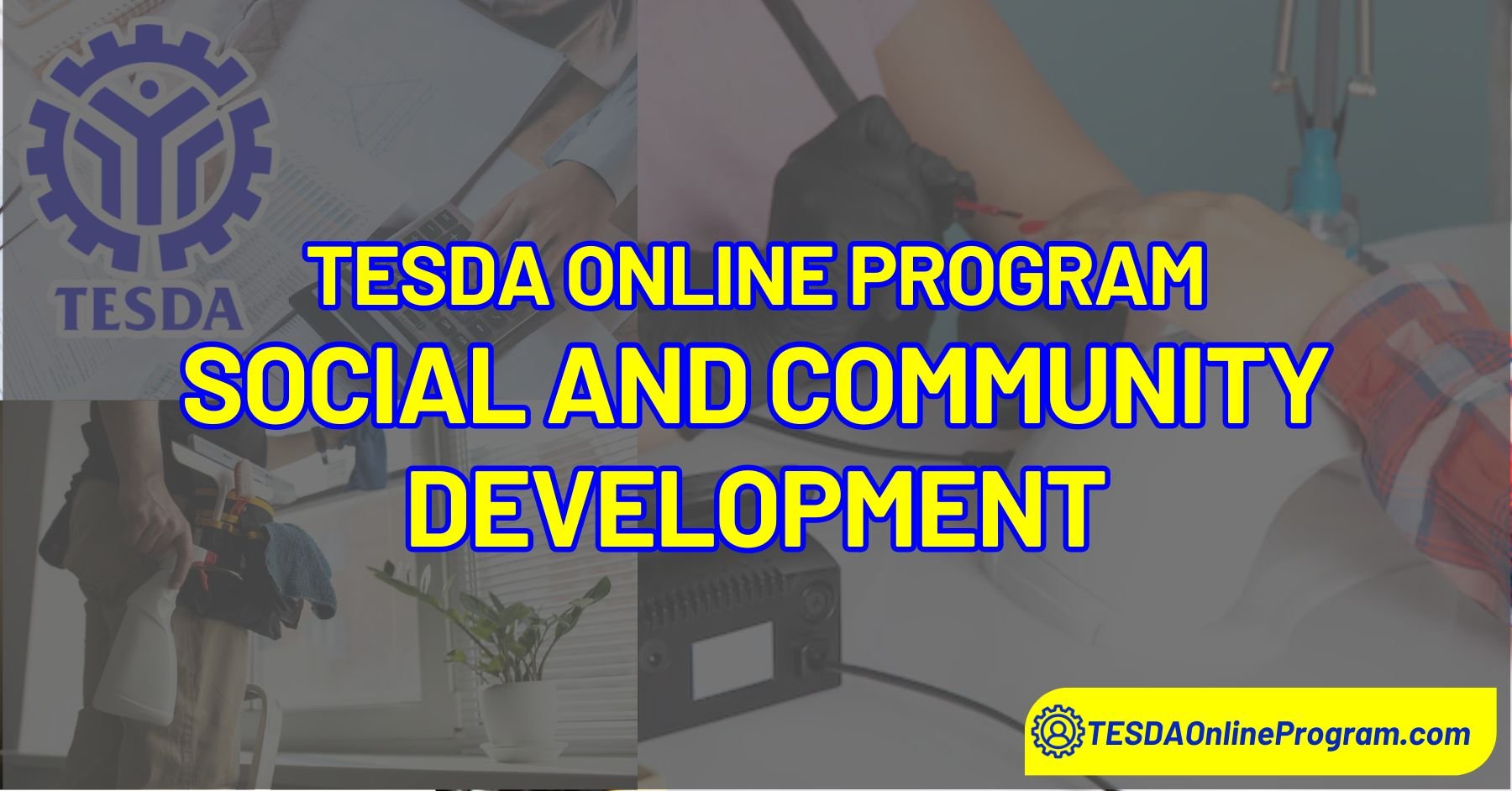The TESDA Online Program (TOP) offers a range of free, accessible courses designed to help Filipinos gain valuable skills and certifications for employment opportunities. Among the available courses are Beauty Care (Nail Care) Services NC II, Domestic Work NC II, and Bookkeeping NC III, each tailored to meet the specific demands of their respective industries. These online programs make it easier for learners to develop competencies and earn National Certificates (NC) from the comfort of their homes.
Whether you’re looking to start a career as a nail technician, improve your skills in domestic work, or become a certified bookkeeper, TESDA competency-based training prepares you for real-world challenges. With hands-on learning and industry-relevant training, these courses provide a pathway to better job prospects and career growth, empowering participants to achieve their goals.
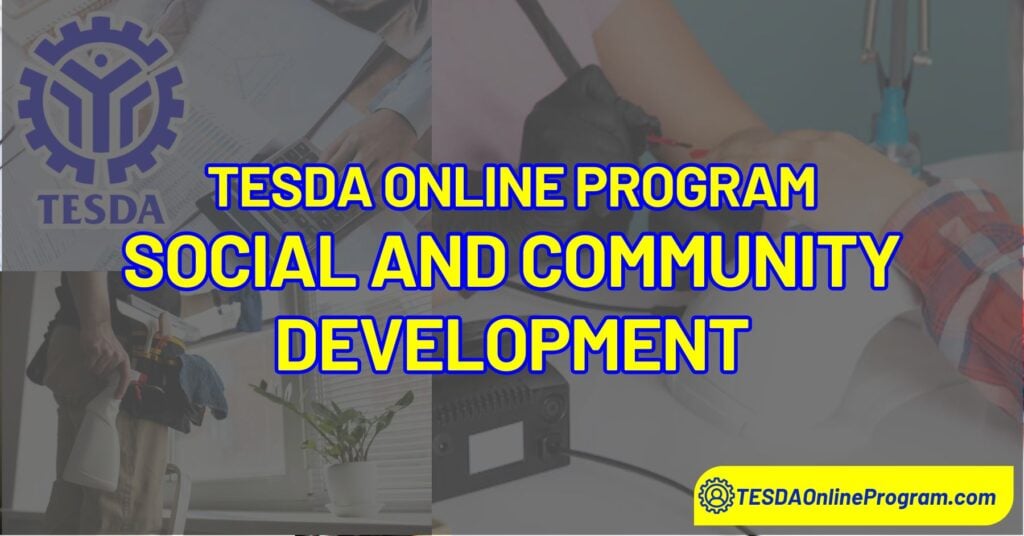
Benefits
Here are some benefits of taking the Social and Community Development Online Courses:
- Flexibility and Convenience: Learn at your own pace, anytime and anywhere, without disrupting your daily schedule. Perfect for those balancing work or other responsibilities.
- Cost-Effective: TESDA Online Program offers free courses, making skills training accessible to many Filipinos.
- Career Advancement: Gain nationally recognized certifications (NC II or NC III) that enhance your employability in fields like beauty care, domestic work, and bookkeeping.
- Practical Skills Development: Acquire hands-on skills like manicure and pedicure, domestic tasks, or financial management, directly applicable to real-world jobs.
- Diverse Opportunities: These courses prepare you for different career paths, whether as a nail technician, domestic worker, or professional bookkeeper.
- Accessible Resources: Online learning materials are readily available, enabling you to revisit lessons and master the competencies required for certification.
- Preparation for Assessment: The programs equip learners with the knowledge and skills needed to pass national assessments and secure certifications.
- Improved Employability: Nationally recognized certifications boost credibility and open doors to local and international job opportunities.
Beauty Care (Nail Care) Services NC II
The Beauty Care (Nail Care) Services NC II qualification includes skills in manicure, pedicure, hand spa, and foot spa services. Candidates must pass an assessment at an accredited center, demonstrating competence in all core units. Those who earn this qualification receive a National Certificate (NC) and can work as a Manicurist, Pedicurist, or Nail Technician.

Units Covered
In this course, there are 7 units available. Each unit is composed of competencies that will help you gain the essential knowledge and skills needed in providing Beauty Care Services (Nail Care) NCII.
Unit 1: Introduction to Nail Care
Lesson 1: The Nail Technician
Lesson 2: The Nail
Lesson 3: The Bones of the Hand
Lesson 4: The Bones of the Foot
Lesson 5: Contraindications
Unit 2: Materials, Tools, and Equipment Used in Nail Care
Lesson 1: Nail Care Equipment
Lesson 2: Nail Care Tools
Lesson 3: Products/Cosmetics
Lesson 4: Sanitation
Unit 3: Basic Techniques
Lesson 1: Basic Technique: Cutting
Lesson 2: Basic Technique: Filing
Lesson 3: Basic Technique: Cleaning
Lesson 4: Basic Technique: Buffing
Lesson 5: Basic Technique: Polishing
Unit 4: Perform Plain Manicure
Lesson 1: Planning the Treatment
Lesson 2: Plain Manicure Procedure
Lesson 3: Plain Manicure: Polishing
Unit 5: Perform Hand Spa
Lesson 1: Planning the Treatment 2
Lesson 2: Exfoliating Treatment
Lesson 3: Paraffin Wax Treatment
Unit 6: Perform Plain Pedicure
Lesson 1: Plain Pedicure Procedure
Lesson 2: Plain Pedicure: Polishing
Unit 7: Perform Foot Spa
Lesson 1: Sanitation
Lesson 2: Exfoliating Treatment 2
Lesson 3: Post-Services: Aftercare and Advice
Lesson 4: Post-Service Sanitation
Note: TESDA is improving the Training for Work Scholarship Program (TOP) by adding pre and post tests. Completing these tests is mandatory to receive a Certificate of Completion, ensuring program excellence.
Domestic Work NC II
TESDA Online Program (TOP) offers accessible training for Filipinos, including the Domestic Work NC II online course. This course equips participants with skills in cleaning, food preparation, laundry, and childcare. Upon completion, learners earn a National Certificate (NC) II, essential for domestic work. Achieve your career goals from the comfort of home with TESDA.

Modules
There are 5 modules in this course that will equip you with the necessary knowledge and skills to perform domestic work services. Each module contains information about relevant laws, regulations, and standards in domestic work, as well as practical demonstrations and hands-on activities to enhance your learning experience.
Module 1: Introduction to Domestic Service
This course equips domestic workers with the necessary knowledge, skills, and attitude to excel in their roles. Topics covered include the domestic service sector, professional work habits, occupational health and safety, maintaining client relationships, and self-performance management.
UNIT 1: Familiarizing the Domestic Service Sector
Lesson 1: Overview of the Domestic Service Sector
Lesson 2: Professional Work Habits and Skills of a Domestic Worker
By the end of this unit, the learner should be able to:
- Explain basic concepts related to the domestic service sector
- Exhibit the professional work habits and skills of a domestic worker.
UNIT 2: Fundamentals of Domestic Service
Lesson 1: Practicing Occupational Health and Safety
Lesson 2: Maintaining an Effective Relationship with Clients
Lesson 3: Managing Own Performance
By the end of this unit, the learner should be able to:
- Carry out occupational health and safety procedures
- Maintain effective relationships with clients
- Manage own performance.
Module 2: Cleaning Rooms and Kitchen
This course helps you learn the knowledge, skills, and attitudes needed to clean different areas of your home effectively. You’ll learn proper procedures for wearing personal protective equipment, cleaning ceilings, walls, and floors, making beds, washing dishes, cleaning kitchen appliances, and sanitizing various areas.
UNIT 1: Preparing of Cleaning Supplies, Tools, and Equipment
Lesson 1: Cleaning Supplies, Tools, and Equipment
Lesson 2: Removing Stains
By the end of this unit, the learner should be able to:
- Determine the usage of the different cleaning supplies, equipment, and materials
- Perform stain removal techniques based on the standard procedure.
UNIT 2: Cleaning Rooms
Lesson 1: Types of Household Areas
Lesson 2: Cleaning Furniture and Fixtures
Lesson 3: Cleaning Surfaces and Floors
By the end of this unit, the learner should be able to:
- Identify the different types and designs of household areas
- Clean furnishing and fixtures based on the standard procedure
- Clean surfaces and floors based on the standard procedure
- Clean bedrooms
UNIT 3: Cleaning Bedrooms
Lesson 1: Types of Beds, Bed Linens, and Fabrics
Lesson 2: Cleaning the Bedroom
By the end of this unit, the learner should be able to:
- Identify the different types beds, cots, bed linens, and fabrics
- Clean and make-up beds and cots.
UNIT 4: Cleaning the Bathroom
Lesson 1: Cleaning Bathroom Walls, Ceilings, and Ceiling Fittings
Lesson 2: Cleaning Bathtub, Lavatory, and Toilet Bowls
Lesson 3: Cleaning Bathroom Accessories
Lesson 4: Replenishing Bathroom Supplies
By the end of this unit, the learner should be able to:
- Clean bathroom walls, ceilings, and ceiling fittings following the standard procedure
- Clean toilet and bathroom following the standard procedure
- Perform filling-up, cleaning, and proper disposal of bathroom supplies
- Clean bathroom accessories according to the standard procedure.
UNIT 5: Cleaning the Kitchen
Lesson 1: Washing Kitchen Utensils and Linens
Lesson 2: Cleaning Kitchen Appliances
Lesson 3: Cleaning Kitchen Surfaces, Furniture, and Fixtures
Lesson 4: Organizing Kitchen Supplies
By the end of this unit, the learner should be able to:
- Wash kitchen utensils and linens based on the standard procedure
- Clean kitchen appliances following the proper procedure
- Clean the kitchen area following the standard procedure
- Organize kitchen supplies based on the standard procedure.
UNIT 6: Maintaining and Sanitizing Rooms
Lesson 1: Sanitizing Rooms
Lesson 2: Performing Routine Maintenance
By the end of this unit, the learner should be able to:
- Measure and mix sanitizing chemicals safely and properly
- Perform routine maintenance.
Module 3: Washing and Ironing Clothes and Linens
This course covers essential knowledge, skills, and attitudes required for washing and ironing clothes and linens as a domestic worker. You will learn proper procedures for washing, ironing, and organizing, enabling you to excel in your role.
UNIT 1: Performing Laundry
Lesson 1: Preparing Laundry Supplies, Materials, and Equipment
Lesson 2: Sorting Clothes and Linens
Lesson 3: Washing Clothes, Linens, and Fabrics
By the end of this unit, the learner should be able to:
- Prepare the laundry before washing based on the standard procedure
- Wash clothes, linens, and fabrics based on the standard procedure
UNIT 2: Drying and Ironing Clothes, Linens, and Fabrics
Lesson 1: Drying Clothes, Linens, and Fabrics
Lesson 2: Ironing Clothes and Linens
Lesson 3: Folding and Organizing Clothes and Linens
By the end of this unit, the learner should be able to:
- Dry-washed clothes, linens, and fabrics according to procedures
- Iron clothes, linens, and fabrics in accordance with the standard procedures.
Module 4: Preparing Hot and Cold Meals
This self-paced course equips domestic workers with the knowledge, skills, and attitudes to prepare hot and cold meals. It covers cooking ingredients, methods for various dishes, and procedures for appetizers, salads, sandwiches, and desserts. Emphasizing meal presentation and food storage.
UNIT 1: Preparing for Cooking
Lesson 1: Common Cooking Ingredients
Lesson 2: Purchasing Ingredients
Lesson 3: Ensuring Food and Occupational Safety and Health
By the end of this unit, the learner should be able to:
- Determine desirable qualities of common cooking ingredients
- Purchase the proper ingredients
- Follow standards relevant to preparing food/meals
UNIT 2: Fundamentals of Cooking
Lesson 1: Common Cooking Tools, Utensils and Equipment in the Household
Lesson 2: Measurements and Conversions
Lesson 3: Basic Knife Skills
Lesson 4: Common Cooking Methods
By the end of this unit, the learner should be able to:
- Identify different cooking tools, utensils and equipment
- Convert kitchen measurements
- Demonstrate different knife skills
- Identify different cooking methods
UNIT 3: Preparing Hot Meals
Lesson 1: Preparing Meat Dishes
Lesson 2: Preparing Poultry Dishes
Lesson 3: Preparing Seafood Dishes
Lesson 4: Preparing Eggs, Vegetables, and Farinaceous Dishes
By the end of this unit, the learner should be able to:
- Prepare meat dishes
- Prepare poultry dishes
- Prepare seafood dishes
- Prepare egg dishes
- Prepare vegetable dishes
- Prepare farinaceous dishes
- Present hot meals
UNIT 4: Preparing Cold Meals and Desserts
Lesson 1: Preparing Appetizers, Salads and Sandwiches
Lesson 2: Preparing Desserts
By the end of this unit, the learner should be able to:
- Prepare appetizers, salads, and sandwiches
- Prepare desserts
- Present cold meals and desserts
UNIT 5: Storing and Converting Unconsumed Food
Lesson 1: Storing Unconsumed Food
Lesson 2: Converting Unconsumed Food
By the end of this unit, the learner should be able to:
- Store unconsumed food/ingredients properly
- Convert unconsumed food/ingredients into new dishes
Module 5: Providing Food and Beverage Service
This self-paced course covers the essential knowledge, skills, and attitudes required for domestic workers to effectively prepare the dining area, set up tables, serve food and beverages, and clear tables as part of their household responsibilities.
UNIT 1: Preparing the Dining Area
Lesson 1: Preparing the Dining Area
Lesson 2: Setting Up the Table
By the end of this unit, the learner should be able to:
- Prepare the dining area
- Set up the table properly
UNIT 2: Serving Food and Beverages and Clearing Table
Lesson 1: Serving Food and Beverage
Lesson 2: Clearing the Table
By the end of this unit, the learner should be able to:
- Serve food and beverages to clients
- Clear table after use
Note: Upon completion of each module, or specific modules, you will be awarded a certificate to recognize your achievements and demonstrate your expertise in the respective subject matter. These certificates serve as a testament to your dedication and commitment to continuous learning.
Bookkeeping NC III
Bookkeeping NC III is one of the courses offered by TESDA Online Program. It is a competency-based training program that prepares learners to become efficient bookkeepers in various industries. In this course, students will learn how to record and summarize financial transactions, prepare different types of financial statements, and analyze financial data. They will also be trained on how to use accounting software and other computerized tools for bookkeeping tasks.
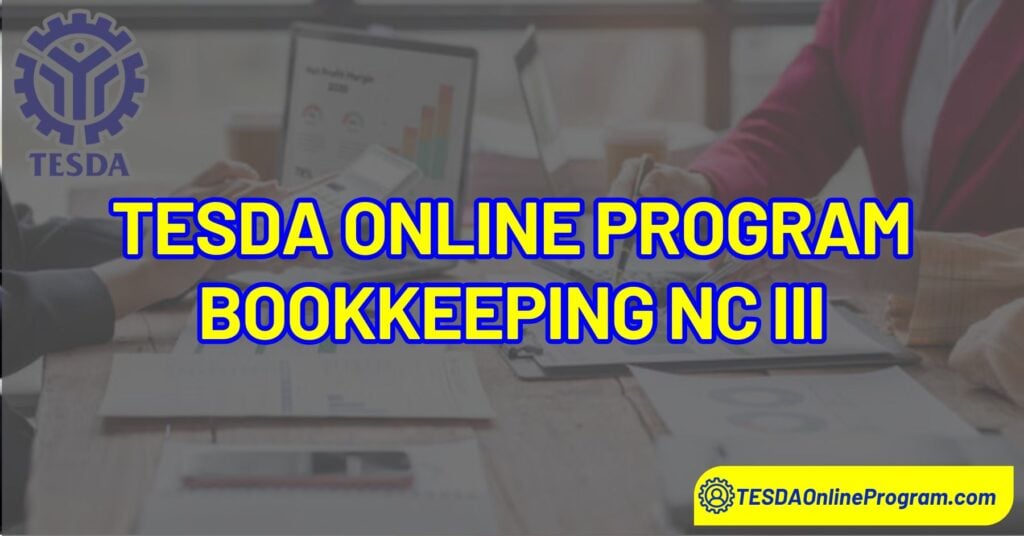
Modules
There are 6 modules in Bookkeeping NC III online course, which are the following:
Module 1: Introduction to Bookkeeping
This module covers the key skills and knowledge needed to successfully handle the roles and responsibilities of a Bookkeeper. It includes lessons on essential workplace practices and the basics required for the job.
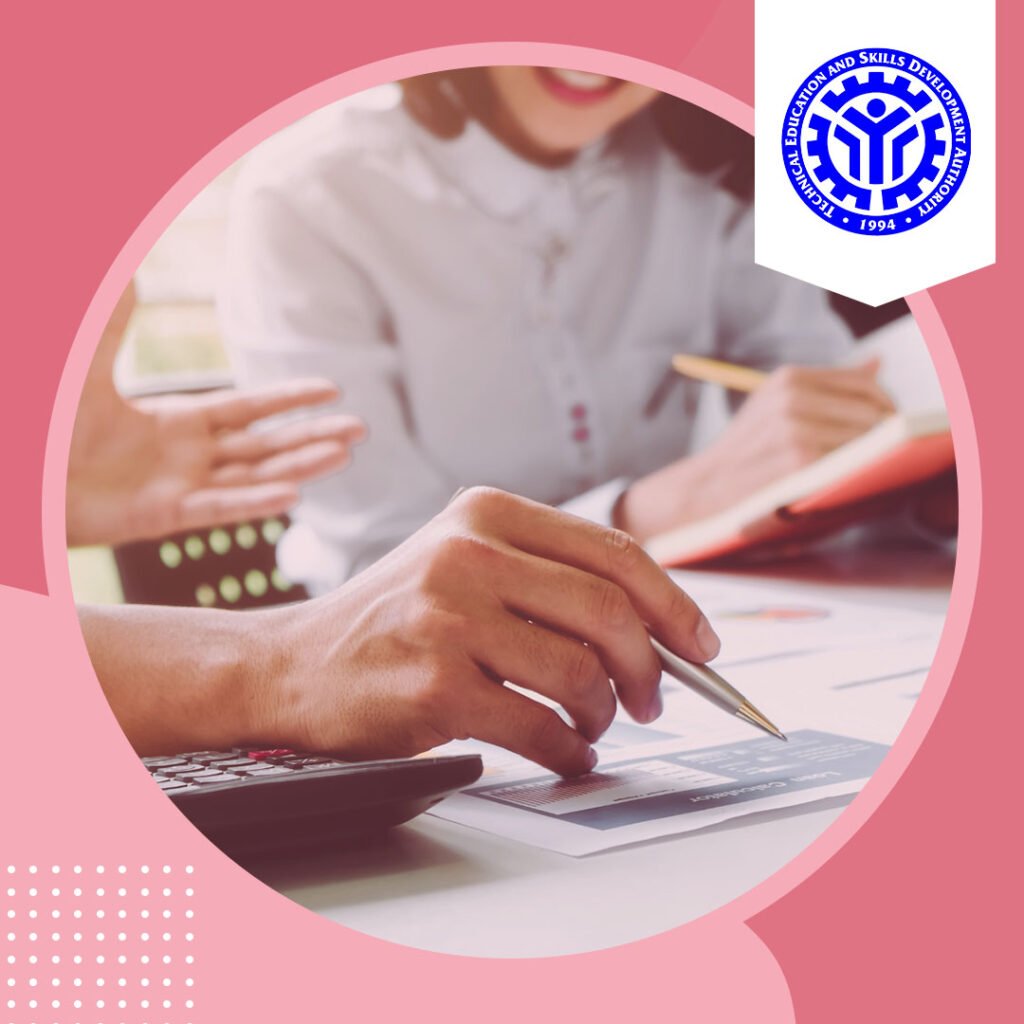
UNIT 1: Working in the Bookkeeping Industry
LESSON 1: Overview of Bookkeeping
LESSON 2: Collaboration and Communication in the Workplace
LESSON 3: Practicing Occupational Health and Safety Measures in the Workplace
At the end of this unit, you should be able to:
- Describe the Industry of Bookkeeping
- Apply leadership skills within the workplace
- Practice occupational health and safety measures in the workplace
UNIT 2: Fundamentals of Bookkeeping
LESSON 1: Practicing Mathematical Operations
LESSON 2: Navigating ICT Technologies
At the end of this unit, you should be able to:
- Perform basic mathematical operations
- Navigate ICT Technologies
Module 2: Journalizing Transactions
This module teaches the knowledge, skills, and mindset needed to record business transactions in an accounting journal. It includes lessons on the best practices and procedures for journalizing transactions.
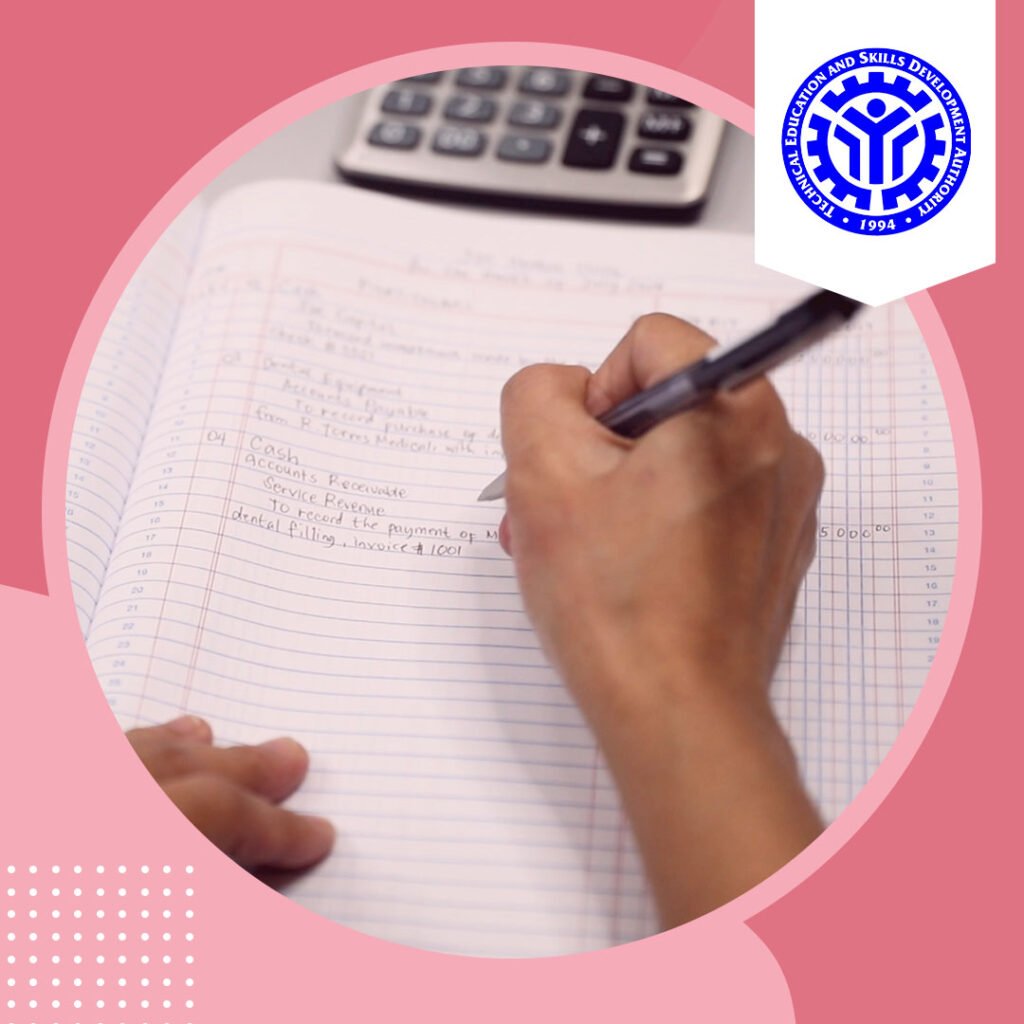
UNIT 1: Preparing Charts for Journalizing Transactions
LESSON 1: Familiarizing the Generally Accepted Accounting Principles (GAAP)
LESSON 2: Preparing Charts of Accounts
At the end of this unit, you should be able to:
- Determine the components of journalizing accounting transactions.
- Prepare charts of accounts.
UNIT 2: Analyzing Documents for Journal Entry
LESSON 1: Familiarizing Journal Entry Documents
LESSON 2: Establishing the Principles of Analyzing Documents
At the end of this unit, you should be able to:
- Identify the different types of journal entry documents.
- Analyze documents for journal entry.
UNIT 3: Preparing Journal Entry
LESSON 1: Preparing Data for Journalizing Transactions
LESSON 2: Closing the Books of Account
At the end of this unit, you should be able to:
- Prepare journal entry transactions.
- Encode transaction details in the journal.
This module teaches you how to post transactions both manually and digitally. It covers the basics, including formats and procedures, to help you build a strong foundation.
Module 3: Posting Transactions
This module shows you how to record transactions manually and digitally. It explains the basics, including formats and steps, to help you develop a solid understanding.
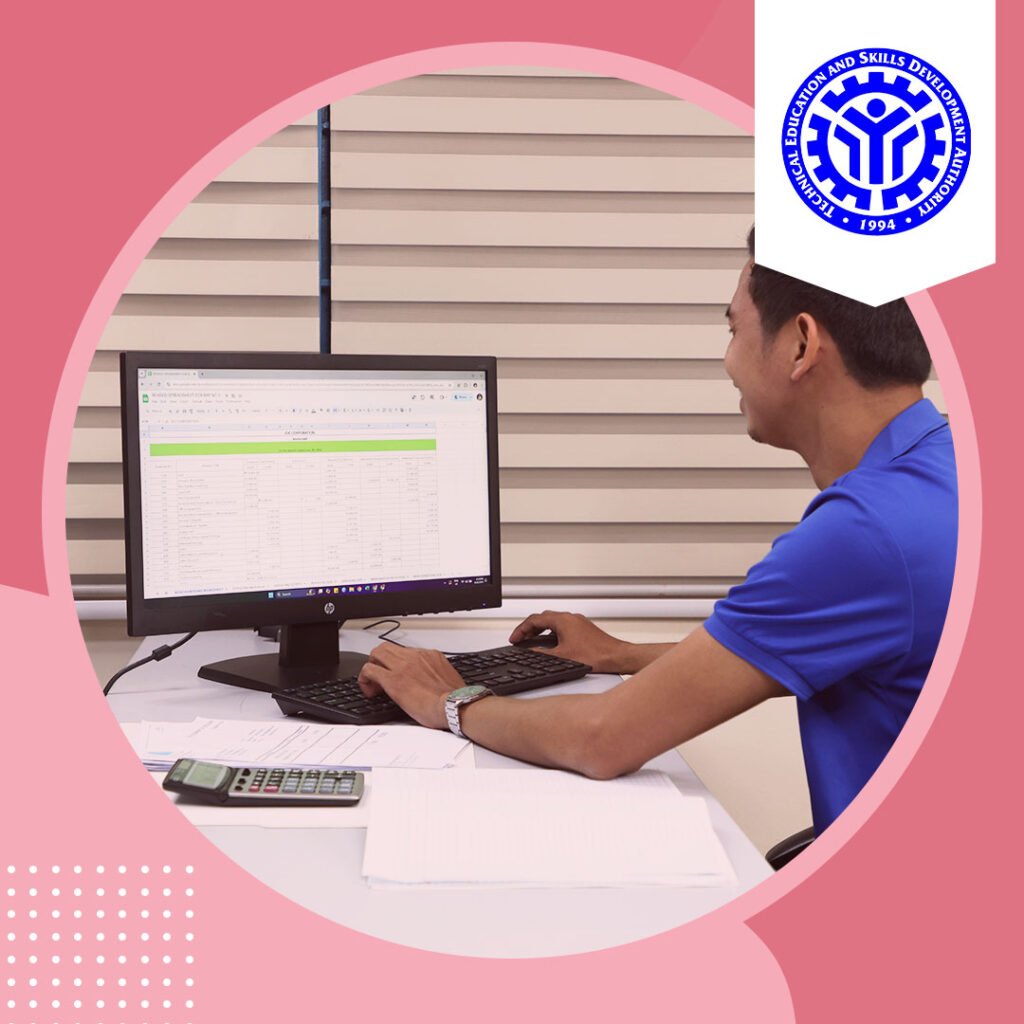
Unit 1: Preparing Ledgers for Posting Transactions
LESSON 1: Understanding Ledger Accounts
LESSON 2: Preparing the Ledger for Posting Transactions
At the end of this unit, you should be able to:
- Identify the different ledger accounts.
- Prepare a ledger for posting transactions.
Unit 2: Posting Entries to the Ledger
LESSON 1: Posting Journal Entries to the Ledger
LESSON 2: Summarizing Entries in the Ledger Account
At the end of this unit, you should be able to:
- Post journal entries into a ledger account.
- Summarize entries in the ledger accounts.
Module 4: Preparing Trial Balance
This module teaches you how to list accounts, transfer trial balances from a ledger, and summarize them. It includes lessons on key points to consider when preparing and summarizing a trial balance.
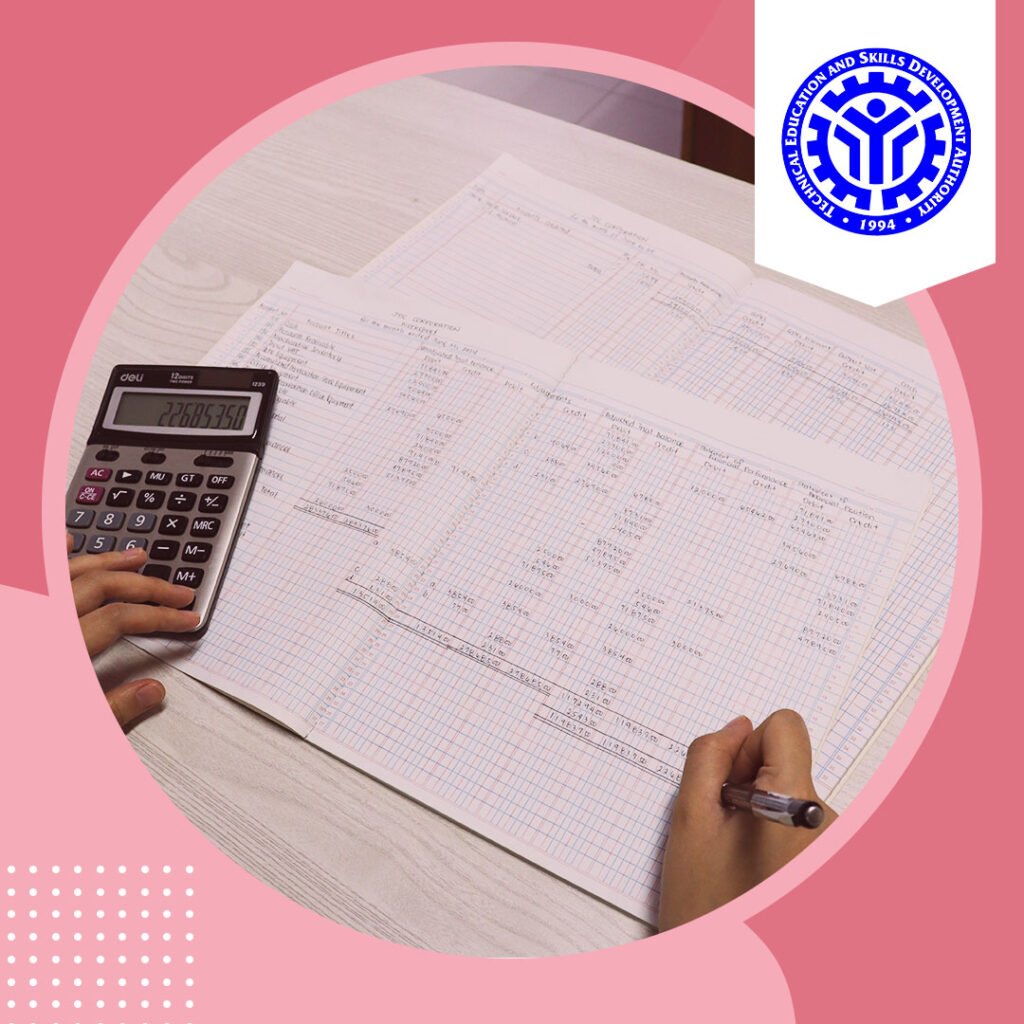
UNIT 1: Preparing the Trial Balance
LESSON 1: Determining the Components of Trial Balance
LESSON 2: Fundamental Principles in Preparing Trial Balance
At the end of this unit, you should be able to:
- Identify the characteristics of trial balancing.
- Demonstrate the fundamental principles in preparing a trial balance.
UNIT 2: Summarizing Trial Balances
LESSON 1: Preparing Trial Balances
LESSON 2: Locating and Correcting Errors in Trial Balance
At the end of this unit, you should be able to:
- Summarize three types of trial balance.
- Correct errors in trial balancing.
Module 5: Preparing Financial Reports
This module teaches you how to prepare financial reports manually. It includes lessons and topics to guide you through the process.
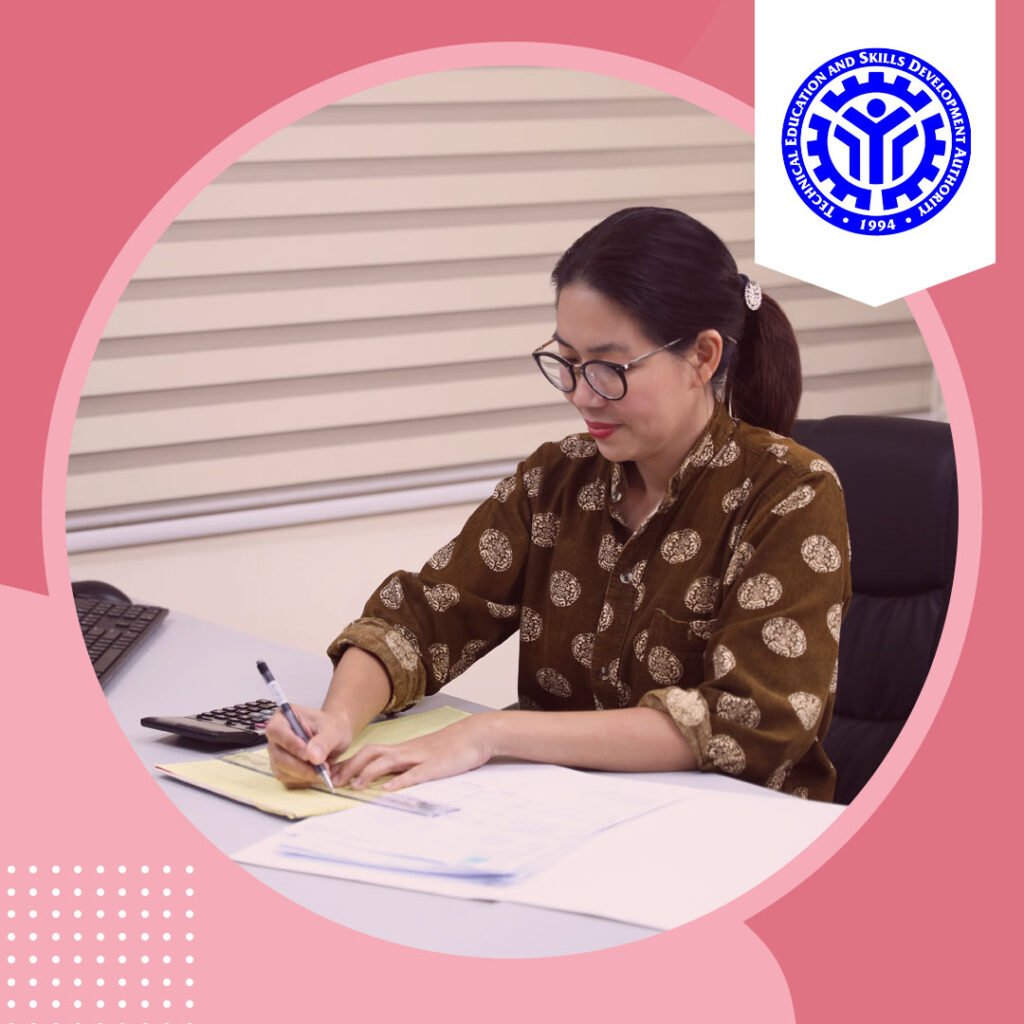
UNIT 1: Preparing Financial Statements
LESSON 1: Verifying Financial Data
LESSON 2: Preparing Financial Statements
At the end of this unit, you should be able to:
- Identify the components of financial data.
- Interpret the principles of financial statements.
- Prepare financial statements.
UNIT 2: Conducting Financial Analysis and Reports
LESSON 1: Analyzing Financial Statements
LESSON 2: Fundamentals of Notes to Financial Statements
At the end of this unit, you should be able to:
- Analyze financial statements.
- Conduct financial reports.
Module 6: Reviewing Internal Control System
This module teaches the knowledge, skills, and mindset needed to review and assess how well a firm follows its internal control manual. It includes lessons on evaluating its effectiveness and preparing the manual.
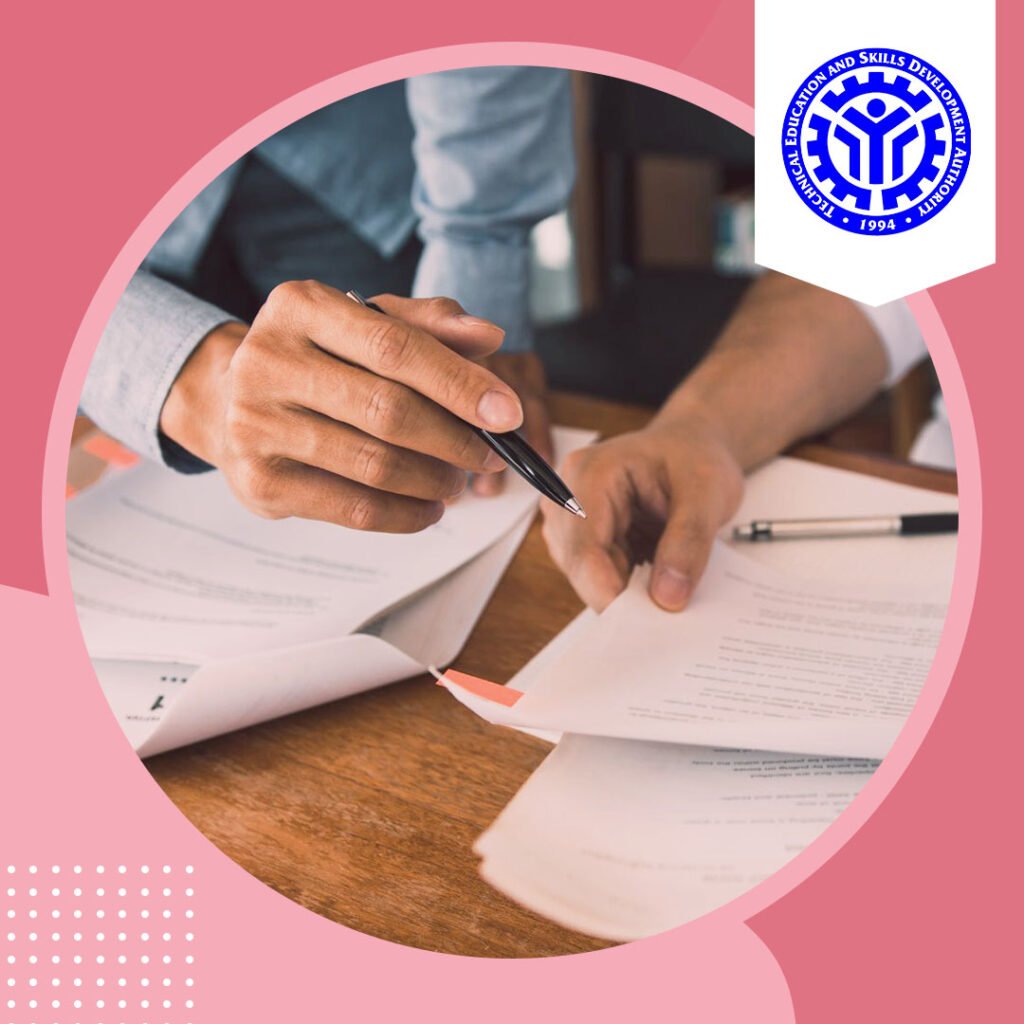
UNIT 1: Checking the Policy for Compliance
LESSON 1: Components of Internal Control System
LESSON 2: Fundamentals of Internal Control System
At the end of this unit, you should be able to:
- Define the internal control system.
- Identify the fundamentals of the internal control system.
UNIT 2: Preparing Policy Compliance Report
LESSON 1: Checking Internal Control Policy Compliance Report
LESSON 2: Preparing Policy Compliance Report
At the end of this unit, you should be able to:
- Check the internal control policy compliance report.
- Prepare the policy compliance report.
Note: Upon completion of each module, or specific modules, you will be awarded a certificate to recognize your achievements and demonstrate your expertise in the respective subject matter. These certificates serve as a testament to your dedication and commitment to continuous learning.
Summary
The TESDA Online Program offers accessible training courses in various fields, including Beauty Care (Nail Care) Services NC II, Domestic Work NC II, and Bookkeeping NC III. These courses provide Filipinos with valuable skills for professional growth. Beauty Care NC II focuses on manicure, pedicure, and spa services, preparing learners for roles like Nail Technician. Domestic Work NC II equips participants with essential skills in household management, such as cleaning, childcare, and food preparation. Bookkeeping NC III trains learners in financial record-keeping, statement preparation, and using accounting software. Each course awards a National Certificate (NC) upon completion, opening doors to career opportunities.

